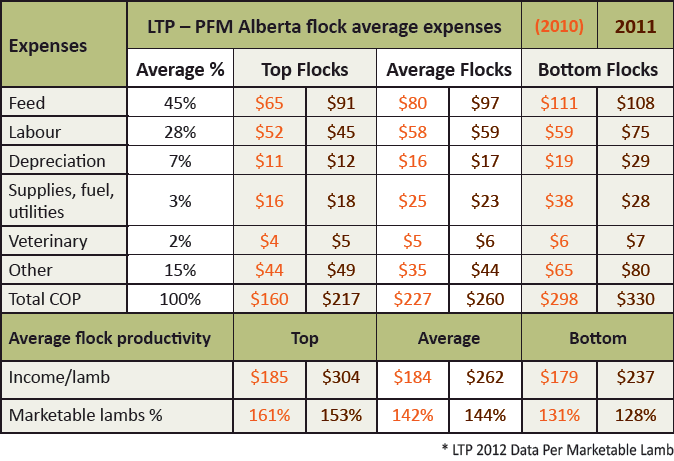| | Mastering Cost of Production
What is cost of production (COP)?
- Sheep farms, flock operations, lamb enterprises are all in business to produce lambs for meat, genetics, fibre and milk for sale to consumers.
- Calculating cost of production tells you how much it costs to raise a marketable lamb.
- Where carcass information is available on slaughter lambs, costs and returns can be further calculated on the pound/kilogram of meat sold.
Marketable lambs earn income for the lamb operation or, in the case of replacement animals kept in the flock, build flock value. “Marketable lambs” include those retained for breeding as well as those sold for breeding or slaughter. You need flock production information. The better the production information you have, the better flock management decisions you can make. How many ewes were exposed to the ram? How many of those ewes lambed? Which to sell or retain? How many lambs were born, survived, were weaned and were available to market? You also need good financial information. How many marketable lambs are needed to generate enough income? What are the total flock costs in each marketable lamb? Mastering cost of production is key to a profitable business.
Why calculate COP?
Knowing what it costs to produce every marketable lamb is the single-most important piece of information that a producer needs to run a successful lamb operation. Understanding what factors in running a lamb operation have the greatest impact on cost of production is a powerful tool to increase flock profitability. Pinching pennies on mineral or vaccines isn’t going to make much of a change to your bottom line. Managing the big ticket items of ewe productivity, feed and labour, makes the biggest difference to your bottom line. Knowing your COP allows you to:
- Analyze how your lamb business is performing.
- Establish the income your operation needs to earn to cover costs.
- Evaluate your operation from year to year.
- Analyze key areas of your operation to make better decisions.
- Gather consistent cost of production data from a number of operations to develop industry benchmarks for different types of sheep operations.
- Compare your operation to other lamb production operations to make your flock performance level more meaningful.
What do you need to calculate COP?
Financial performance records
- Financial records must be specific to the “lamb enterprise”. Most farms have more than one enterprise. Separate the custom hay, crop or other livestock expenses and revenue from your lamb enterprise.
- Your bookkeeping system needs to be able to track expenses by the “enterprise”. All newer computerized bookkeeping applications can do this.
- You need to allocate a percentage of your land and capital costs specifically to the sheep enterprise to know your total costs. An accountant can advise you on how to do this. Your bookkeeper can set up your financial record system to automatically factor this in.
- If bookkeeping isn’t your area of expertise, or interest, hiring a bookkeeper is an option that ensures good financial records are available when you need them for decision-making.
Animal production records
- You need to know how many animals you have at the start and at the end of the year (inventories), plus how many lambs were born, sold, transferred into, or out of, the flock.
- New tools like Sheepbytes can help you manage and monitor feed costs the ‘big ticket item’.
- Computerized flock data management software programs, particularly ones that use RFID technology, can provide easier data collecting, reporting and tracking of information on ewe productivity.
The ability to analyze financial and production data
- Calculating COP is easy in principle. For example, COP per lamb sold is simply all costs related to the enterprise divided by the total number of lambs sold.
- Calculating COP becomes more difficult when you compare year to year performance. Operations change from year to year and those changes need to be taken into account.
- Differences in lamb operations make comparisons difficult. Lamb operations are big, small; some own land, some rent; they put up their own feed, or buy feed; some hire labour or have only family members; and more and more as costs increase some are renting more land, equipment or buildings.
- The Flock Snapshot analysis tool was developed to help lamb producers take into account some of the many variables and more easily assess flock performance.
The table below just provides some comparison numbers. Flock managers need to develop financial and production data specific to the flock enterprise.

What does COP tell you?
Good COP information tells you quickly the average price you earned for lambs last year and what you spent on producing them. It provides you with an overview of the performance of your lamb enterprise and it gives you the ability to more carefully track your business. Managing cost of production is the basis of good business management whether you produce lambs, flowers, steel pipe or cars. The Lamb Traceability Pilot project (LTP) gathered and analyzed cost of production data from 2009 to 2011 gathered from 120 farms across Canada. Data analysis identified ‘top’, ‘average ‘and ‘bottom’ performing flocks and provides an even clearer picture of flock performance:
- Industry average benchmarks that you can compare your own flock performance with.
- Real targets achieved by other producers can help you set realistic goals for improving your flock’s performance.
Setting up record-keeping systems to collect the right data to calculate COP takes time. A good accounting program, good flock data management software and tools like the Flock Snapshot simplify the process. The benefits of managing cost of production include: better ability to identify and then address problem areas; provide you with a solid knowledge of expenses and income for budgeting and planning; and not least of all, the peace of mind that comes with knowing that you are using the best business practices to manage your operation.
For more information on COP:
|
|